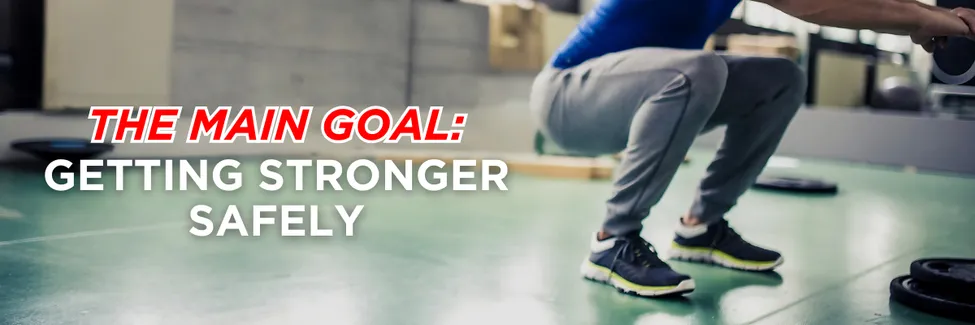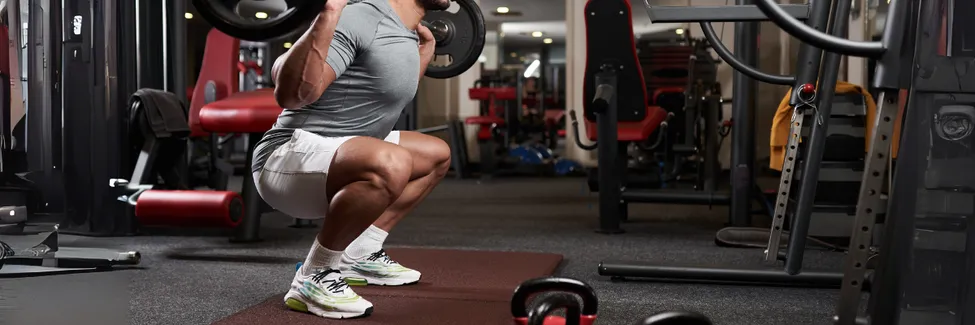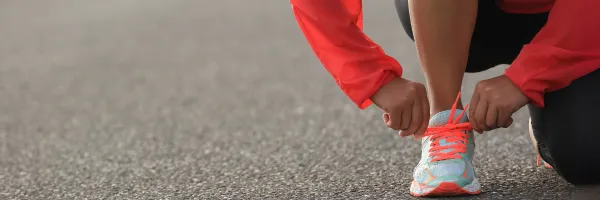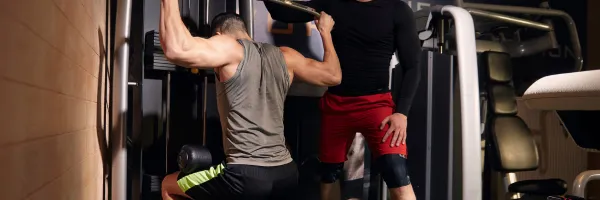Stronger After 40: How Box Squats and Trap Bar Deadlifts Might Be Your Secret to Building Strength Without the Risk of Injury
5 MINUTE READ

By: Dr. Jerry Yoo
CEO & Founder, Next Level Physio
Getting stronger as you age doesn’t have to mean pushing through the aches and pains associated with traditional exercises like the back squat or conventional deadlift.
If you’ve experienced the discomfort or injury risks that often come with these movements—especially if you’ve dealt with back pain in the past—it’s understandable to be hesitant to return to them.
However, it’s important to remember that building strength after 40 is still very much possible, and sometimes, you just need to use the right tools for the job.

Today, I’ll dive into why box squats and trap bar deadlifts might be the game-changing alternatives you’ve been searching for—especially if you’ve ever felt that traditional strength training movements weren’t right for you.
We’ll also explore how these exercises can fit seamlessly into a program designed by a physio who understands the nuances of working with athletes over 40, ensuring you get all the gains, minus the risks.

When it comes to strength training, the goal is simple: applying a stimulus that leads to adaptation. Whether that’s increasing lean muscle mass, improving nervous system efficiency, or simply getting stronger, the right exercises can help trigger those changes in your body.
But here’s the catch—exercises are just tools. And just like a carpenter wouldn’t use a hammer to screw in a screw, you shouldn’t feel obligated to use exercises like the back squat or conventional deadlift if they don’t work for your body.
The key is finding movements that give you the benefits you’re after without unnecessarily stressing your joints, muscles, or spine. Especially when you’ve had past injuries or concerns, this is where tools like the box squat and trap bar deadlift can step in and offer real advantages.
Why Box Squats and Trap Bar Deadlifts Are Great for Those Over 40
While the back squat and conventional deadlift are staples in many strength programs, they’re not the best for everyone, particularly if you’re dealing with past injuries or are simply trying to avoid stressing the lower back. Both exercises can put a lot of strain on the spine and hips, and for people over 40, this can increase the risk of injury.
That’s where box squats and trap bar deadlifts come into play:

1. Box Squats: Less Eccentric Demand, More Power
Box squats are a fantastic alternative to traditional squats, especially if you’re worried about straining your back. Here’s why: in a box squat, you start by sitting down on a box at a controlled depth and then explode upward to stand back up.
This movement removes the excessive eccentric (lowering) phase of the squat, which is what typically causes the soreness and strain on the muscles and joints. The box also serves as a cue to ensure you’re hitting the right depth without overloading your lower back.
What’s great about box squats is that they still offer a potent neural stimulus—meaning they’ll help improve your ability to produce force without the risk of overstraining your body. Plus, they allow you to work on building strength in a more joint-friendly way.
They are especially effective in an in-season or high-volume program when you want to retain strength without excessive fatigue or soreness while training for your next race.
Here's an example of a box squat (bench works fine, too!)Add a barbell, kettlebell or dumbbell to increase the load.
2. Trap Bar Deadlifts: Target Strength Without the Strain
The conventional deadlift has a long track record for building strength but can be brutal on the lower back. For those over 40, especially those with any history of back issues, the trap bar deadlift is a solid alternative.
The design of the trap bar allows you to stand inside the bar, shifting the load more evenly through your body. This helps reduce the stress on your lower back by keeping your torso more upright throughout the movement. The motion itself is simpler and safer, with a more natural line of movement for the hips and spine.
You get all the benefits of building lower body and posterior chain strength but with far less risk of injury. And let’s face it—who doesn’t want the mental relief of not having to worry about the same old strains and tweaks?
In case you have no idea what a trap bar deadlift looks like:
Exercise Variation: Keep It Fresh and Effective
One of the great things about using exercises like box squats and trap bar deadlifts is the element of variety they bring to your strength program.
After 40, it’s not just about getting stronger—it’s about keeping the process enjoyable and sustainable. As we age, the mental relief of doing exercises that don’t aggravate past injuries is huge.
Adding these movements into your routine means you won’t get bored, and you won’t burn out. Plus, by incorporating a variety of exercises that break up the eccentric demands of movements like the back squat or conventional deadlift, you’re helping reduce overall soreness, which is a win when you’re training consistently.

The Real Magic: Building Strength Without Breaking Your Body
What’s the real benefit of box squats and trap bar deadlifts? They help you build strength with minimal strain, allowing you to work harder in your training without feeling run down. They also offer a mental break from the conventional exercises that many people find taxing or intimidating.
Over 40 and still want to get stronger? It’s not only possible; it’s smart to think outside the box (literally). And even if you can’t access the perfect equipment at your gym, don’t worry—these movements can still be tailored to whatever you have available. You can always substitute with variations or use dumbbells or barbells to work similar movement patterns.

Why You Need a Physio-Guided Strength Program
While box squats and trap bar deadlifts are amazing tools, the most important element of any strength training program—especially for those over 40—is the structure.
If you’ve been hesitant to lift heavy weights because of the fear of injury or past bad experiences, working with a physio-guided strength program could be your solution. A physiotherapist can assess your mobility, strength, and injury history to develop a tailored strength program that gets you stronger while keeping you safe.
Whether you’re lifting in the gym or at home, the right guidance can help you optimize your movements, correct imbalances, and ensure you’re doing exercises that fit your body’s needs.
Getting stronger as you age doesn’t have to mean pushing through the aches and pains associated with traditional exercises like the back squat or conventional deadlift.
If you’ve experienced the discomfort or injury risks that often come with these movements—especially if you’ve dealt with back pain in the past—it’s understandable to be hesitant to return to them.
However, it’s important to remember that building strength after 40 is still very much possible, and sometimes, you just need to use the right tools for the job.

Today, I’ll dive into why box squats and trap bar deadlifts might be the game-changing alternatives you’ve been searching for—especially if you’ve ever felt that traditional strength training movements weren’t right for you.
We’ll also explore how these exercises can fit seamlessly into a program designed by a physio who understands the nuances of working with athletes over 40, ensuring you get all the gains, minus the risks.

When it comes to strength training, the goal is simple: applying a stimulus that leads to adaptation. Whether that’s increasing lean muscle mass, improving nervous system efficiency, or simply getting stronger, the right exercises can help trigger those changes in your body.
But here’s the catch—exercises are just tools. And just like a carpenter wouldn’t use a hammer to screw in a screw, you shouldn’t feel obligated to use exercises like the back squat or conventional deadlift if they don’t work for your body.
The key is finding movements that give you the benefits you’re after without unnecessarily stressing your joints, muscles, or spine. Especially when you’ve had past injuries or concerns, this is where tools like the box squat and trap bar deadlift can step in and offer real advantages.
Why Box Squats and Trap Bar Deadlifts Are Great for Those Over 40
While the back squat and conventional deadlift are staples in many strength programs, they’re not the best for everyone, particularly if you’re dealing with past injuries or are simply trying to avoid stressing the lower back. Both exercises can put a lot of strain on the spine and hips, and for people over 40, this can increase the risk of injury.
That’s where box squats and trap bar deadlifts come into play:

1. Box Squats: Less Eccentric Demand, More Power
Box squats are a fantastic alternative to traditional squats, especially if you’re worried about straining your back. Here’s why: in a box squat, you start by sitting down on a box at a controlled depth and then explode upward to stand back up.
This movement removes the excessive eccentric (lowering) phase of the squat, which is what typically causes the soreness and strain on the muscles and joints. The box also serves as a cue to ensure you’re hitting the right depth without overloading your lower back.
What’s great about box squats is that they still offer a potent neural stimulus—meaning they’ll help improve your ability to produce force without the risk of overstraining your body. Plus, they allow you to work on building strength in a more joint-friendly way.
They are especially effective in an in-season or high-volume program when you want to retain strength without excessive fatigue or soreness while training for your next race.
Here's an example of a box squat (bench works fine, too!)Add a barbell, kettlebell or dumbbell to increase the load.
2. Trap Bar Deadlifts: Target Strength Without the Strain
The conventional deadlift has a long track record for building strength but can be brutal on the lower back. For those over 40, especially those with any history of back issues, the trap bar deadlift is a solid alternative.
The design of the trap bar allows you to stand inside the bar, shifting the load more evenly through your body. This helps reduce the stress on your lower back by keeping your torso more upright throughout the movement. The motion itself is simpler and safer, with a more natural line of movement for the hips and spine.
You get all the benefits of building lower body and posterior chain strength but with far less risk of injury. And let’s face it—who doesn’t want the mental relief of not having to worry about the same old strains and tweaks?
In case you have no idea what a trap bar deadlift looks like:
Exercise Variation: Keep It Fresh and Effective
One of the great things about using exercises like box squats and trap bar deadlifts is the element of variety they bring to your strength program.
After 40, it’s not just about getting stronger—it’s about keeping the process enjoyable and sustainable. As we age, the mental relief of doing exercises that don’t aggravate past injuries is huge.
Adding these movements into your routine means you won’t get bored, and you won’t burn out. Plus, by incorporating a variety of exercises that break up the eccentric demands of movements like the back squat or conventional deadlift, you’re helping reduce overall soreness, which is a win when you’re training consistently.

The Real Magic: Building Strength Without Breaking Your Body
What’s the real benefit of box squats and trap bar deadlifts? They help you build strength with minimal strain, allowing you to work harder in your training without feeling run down. They also offer a mental break from the conventional exercises that many people find taxing or intimidating.
Over 40 and still want to get stronger? It’s not only possible; it’s smart to think outside the box (literally). And even if you can’t access the perfect equipment at your gym, don’t worry—these movements can still be tailored to whatever you have available. You can always substitute with variations or use dumbbells or barbells to work similar movement patterns.

Why You Need a Physio-Guided Strength Program
While box squats and trap bar deadlifts are amazing tools, the most important element of any strength training program—especially for those over 40—is the structure.
If you’ve been hesitant to lift heavy weights because of the fear of injury or past bad experiences, working with a physio-guided strength program could be your solution. A physiotherapist can assess your mobility, strength, and injury history to develop a tailored strength program that gets you stronger while keeping you safe.
Whether you’re lifting in the gym or at home, the right guidance can help you optimize your movements, correct imbalances, and ensure you’re doing exercises that fit your body’s needs.
Ready to get stronger without the risk?
A physio-guided strength program might just be your ticket to finally lifting weights without the worry of back pain or injury. It’s time to build strength, regain confidence, and feel great at any age.
Click HERE to schedule your consultation.
📅 Schedule your FREE Assessment today.
Spots are limited, so grab yours before they fill up.
📍 Cary, NC
📍 Raleigh, NC

About the Author
Dr. Jerry Yoo is the Founder of Next Level Physio.
He has worked with runners and triathletes for over 25 years, and is a clinical running research partner with Rutgers University. Dr. Jerry is an expert at helping runners and lifelong athletes over 40 get back to what they love to do.
He can be reached directly at
Post Address and Mail
Email: info@nlphysio.com
Address
1055 Darrington Drive
Cary, NC 27513
Address
4000 Wake Forest Rd Suite 112, Raleigh, NC 27609
Get In Touch
Hours
Mon - Fri: 9:00 am- 6:00 pm
Sat: By Appointment (8:00 am - 12:00 nn)
Sun: Closed
Phone Number:
919-650-4633


Facebook
Instagram
X
LinkedIn
Youtube
Website